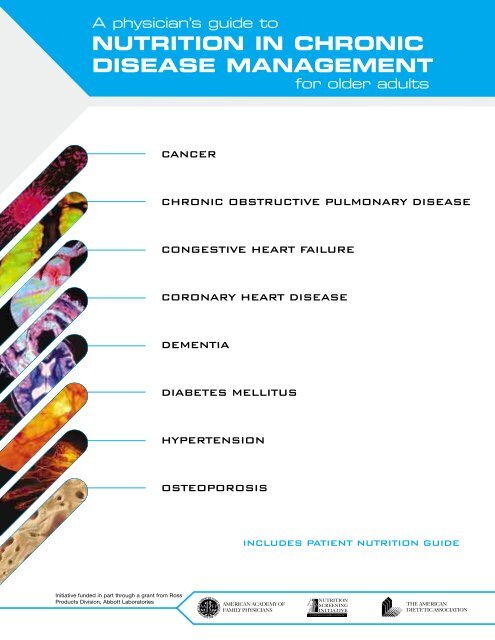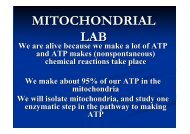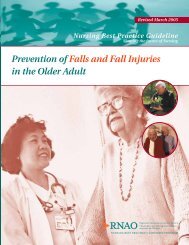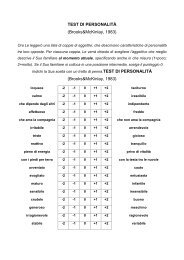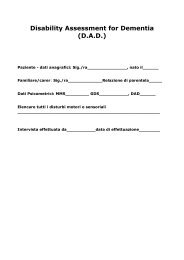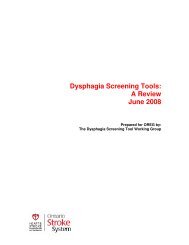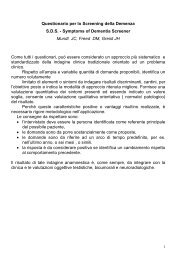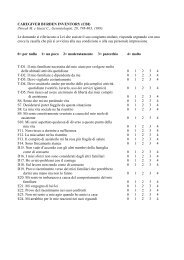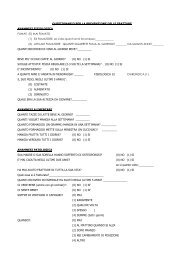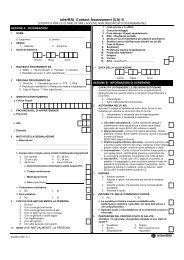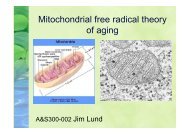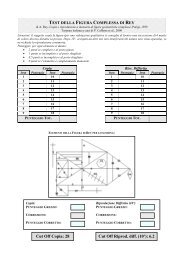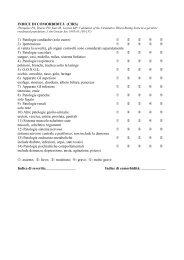A Physician's Guide to Nutrition in Chronic Disease Management for ...
A Physician's Guide to Nutrition in Chronic Disease Management for ...
A Physician's Guide to Nutrition in Chronic Disease Management for ...
Create successful ePaper yourself
Turn your PDF publications into a flip-book with our unique Google optimized e-Paper software.
A physician’s guide <strong>to</strong><br />
NUTRITION IN CHRONIC<br />
DISEASE MANAGEMENT<br />
<strong>for</strong> older adults<br />
CANCER<br />
CHRONIC OBSTRUCTIVE PULMONARY DISEASE<br />
CONGESTIVE HEART FAILURE<br />
CORONARY HEART DISEASE<br />
DEMENTIA<br />
DIABETES MELLITUS<br />
HYPERTENSION<br />
OSTEOPOROSIS<br />
INCLUDES PATIENT NUTRITION GUIDE
Partner Organizations<br />
American Academy of Family Physicians<br />
American Dietetic Association<br />
Authors<br />
Cancer<br />
Albert Barrocas, MD, FACS, Vice President,<br />
Medical Affairs, Pendle<strong>to</strong>n Memorial<br />
Methodist Hospital, New Orleans, Louisiana<br />
*Dana Purdy, RD, LDN (posthumous),<br />
Consultant Dietitian, NutriPro Inc, New<br />
Orleans, Louisiana<br />
Patrick Brady, RN, BSN, OCN, CPT,<br />
Community Nurse Educa<strong>to</strong>r, Wellspr<strong>in</strong>g<br />
Coord<strong>in</strong>a<strong>to</strong>r, Pendle<strong>to</strong>n Memorial Methodist<br />
Hospital, New Orleans, Louisiana<br />
Debra Troutman, RN, OCN, Patient Care<br />
Coord<strong>in</strong>a<strong>to</strong>r, Radiation Therapy, Cancer<br />
Center, Pendle<strong>to</strong>n Memorial Methodist<br />
Hospital, New Orleans, Louisiana<br />
<strong>Chronic</strong> Obstructive Pulmonary <strong>Disease</strong><br />
Sandra Harmon-Weiss, MD, Head of<br />
Government Programs, Aetna U.S.<br />
Healthcare, Blue Bell, Pennsylvania<br />
Congestive Heart Failure<br />
Eric Tangalos, MD, Professor of Medic<strong>in</strong>e and<br />
Chair, Division of Community Internal<br />
Medic<strong>in</strong>e, Mayo Cl<strong>in</strong>ic, Rochester, M<strong>in</strong>nesota<br />
Coronary Heart <strong>Disease</strong><br />
Jan Verderose, MS, RD, CDN, Terri<strong>to</strong>ry<br />
Specialty Manager - Cardiovascular Science,<br />
Wyeth-Ayerst Pharmaceuticals, Sara<strong>to</strong>ga<br />
Spr<strong>in</strong>gs, New York<br />
Dementia<br />
Richard Ham, MD, SUNY Dist<strong>in</strong>guished Chair<br />
<strong>in</strong> Geriatric Medic<strong>in</strong>e, Professor of Medic<strong>in</strong>e,<br />
Professor of Family Medic<strong>in</strong>e, SUNY Upstate<br />
Medical University, Syracuse, New York<br />
Diabetes Mellitus<br />
Jane V. White, PhD, RD, FADA, Professor,<br />
Department of Family Medic<strong>in</strong>e, Graduate<br />
School of Medic<strong>in</strong>e, University of Tennessee-<br />
Knoxville, Knoxville, Tennessee<br />
acknowledgements<br />
The <strong>Nutrition</strong> Screen<strong>in</strong>g Initiative would like <strong>to</strong> acknowledge the follow<strong>in</strong>g organizations<br />
and <strong>in</strong>dividuals who made it possible <strong>to</strong> put <strong>to</strong>gether credible, scientific-based nutrition<br />
<strong>in</strong><strong>for</strong>mation <strong>for</strong> physicians and their patients.<br />
A special thanks <strong>to</strong> Albert Barrocas, MD, FACS, John Coombs, MD, MNS, Jane V. White, PhD,<br />
RD, FADA <strong>for</strong> tirelessly lead<strong>in</strong>g the ef<strong>for</strong>t <strong>to</strong> create this comprehensive nutrition guide.<br />
Hypertension<br />
Jane V. White, PhD, RD, FADA, Professor,<br />
Department of Family Medic<strong>in</strong>e, Graduate<br />
School of Medic<strong>in</strong>e, University of Tennessee-<br />
Knoxville, Knoxville, Tennessee<br />
Osteoporosis<br />
Johanna Dwyer, D.Sc., R.D., Professor of<br />
Medic<strong>in</strong>e and Community Health, Schools of<br />
Medic<strong>in</strong>e and <strong>Nutrition</strong> and Senior Scientist,<br />
Jean Mayer Human <strong>Nutrition</strong> Research Center<br />
on Ag<strong>in</strong>g at Tufts University, and Direc<strong>to</strong>r,<br />
Frances Stern <strong>Nutrition</strong> Center, New England<br />
Medical Center Hospital (In 2001-2 Dr. Dwyer<br />
is serv<strong>in</strong>g as Assistant Adm<strong>in</strong>istra<strong>to</strong>r <strong>for</strong><br />
Human <strong>Nutrition</strong>, Agricultural Research<br />
Service, US Department of Agriculture,<br />
Wash<strong>in</strong>g<strong>to</strong>n, DC)<br />
Reviewers<br />
Jacqelyn Admire-Borgelt, MSPH, Assistant<br />
Division Direc<strong>to</strong>r of Scientific Activities,<br />
American Academy of Family Physicians,<br />
Leawood, Kansas<br />
George Blackburn, MD, PhD, Associate<br />
Professor of Surgery and <strong>Nutrition</strong>, Harvard<br />
Medical School, Beth Israel Deaconess<br />
Medical Center, Bos<strong>to</strong>n, Massachusetts<br />
Dan Brewer, MD, Associate Professor,<br />
Department of Family Medic<strong>in</strong>e, Graduate<br />
School of Medic<strong>in</strong>e, University of Tennessee-<br />
Knoxville, Knoxville,Tennessee<br />
Sue F<strong>in</strong>ch-Brown, RN, A-CCC, Direc<strong>to</strong>r of<br />
Managed Care; President of MMC, Medical<br />
<strong>Management</strong> Consultants, Ripen, Wiscons<strong>in</strong><br />
Donna Cohen, PhD, Professor, Department of<br />
Ag<strong>in</strong>g and Mental Health, University of South<br />
Florida, Tampa, Florida<br />
John Coombs, MD, MNS, TJ Phillips<br />
Professor of Family Medic<strong>in</strong>e, Associate Vice<br />
President <strong>for</strong> Medical Affairs and Associate<br />
Dean, University of Wash<strong>in</strong>g<strong>to</strong>n Academic<br />
Medical Center, Seattle, Wash<strong>in</strong>g<strong>to</strong>n<br />
Judy Dausch, PhD, RD, Senior Manager <strong>for</strong><br />
Regula<strong>to</strong>ry Affairs, American Dietetic<br />
Association, Wash<strong>in</strong>g<strong>to</strong>n, DC<br />
Rebecca Kirby, MS, RD, MD, Family Practice<br />
Physician, El Paso, Texas<br />
Jean L. Lloyd, MS, RD, <strong>Nutrition</strong>ist, U.S.<br />
Adm<strong>in</strong>istration on Ag<strong>in</strong>g, Wash<strong>in</strong>g<strong>to</strong>n, DC<br />
Leah-Rae Mabry, MD, American Academy<br />
of Family Physicians, Public Health<br />
Commission, Pleasan<strong>to</strong>n, Texas<br />
Velimir Matkovic, MD, DSc, Professor,<br />
Departments of Physical Medic<strong>in</strong>e and<br />
Rehabilitation, Medic<strong>in</strong>e, and <strong>Nutrition</strong>,<br />
Direc<strong>to</strong>r Osteoporosis Prevention and<br />
Treatment Center and Bone and M<strong>in</strong>eral<br />
Metabolism Labora<strong>to</strong>ry, The Ohio State<br />
University, Columbus, Ohio<br />
Todd Semla, MS, Pharm D, FCCP, BCPS,<br />
Associate Direc<strong>to</strong>r, Psychopharmacology<br />
Cl<strong>in</strong>ical Research Center, Department of<br />
Psychiatry and Behavioral Sciences, Evans<strong>to</strong>n<br />
Northwestern Healthcare, Evans<strong>to</strong>n, Ill<strong>in</strong>ois;<br />
Cl<strong>in</strong>ical Assistant Professor, Section of<br />
Geriatric Medic<strong>in</strong>e, University of Ill<strong>in</strong>ois at<br />
Chicago College of Medic<strong>in</strong>e, Chicago, Ill<strong>in</strong>ois<br />
Mary Sue Walker, PhD, RD, LDN, Consultant<br />
<strong>in</strong> private practice, Knoxville, Tennessee<br />
Nancy Wellman, PhD, RD, FADA, Professor<br />
and Direc<strong>to</strong>r, National Policy and Resource<br />
Center on <strong>Nutrition</strong> and Ag<strong>in</strong>g, Florida<br />
International University, Miami, Florida<br />
*The NSI would like <strong>to</strong> recognize the outstand<strong>in</strong>g<br />
work of Dana Purdy and her contributions <strong>to</strong><br />
promot<strong>in</strong>g the important role of nutrition <strong>in</strong> the<br />
management of cancer. Dana recently succumbed<br />
<strong>to</strong> her own battle with cancer.<br />
Copyright ©2002 by the <strong>Nutrition</strong> Screen<strong>in</strong>g Initiative (NSI)<br />
The <strong>in</strong>clusion of <strong>in</strong><strong>for</strong>mation <strong>in</strong> “A <strong>Physician's</strong> <strong>Guide</strong> <strong>to</strong> <strong>Nutrition</strong> <strong>in</strong> <strong>Chronic</strong> <strong>Disease</strong> <strong>Management</strong> <strong>in</strong> Older Adults” constitutes neither approval nor endorsement by the American Academy<br />
of Family Physicians, the American Dietetic Association, and the <strong>Nutrition</strong> Screen<strong>in</strong>g Initiative of any brand or specific nutritional products. 64573
A GUIDE TO THE MATERIALS<br />
PURPOSE<br />
Older people have special nutritional needs due <strong>to</strong><br />
age and disease processes.<br />
Public <strong>in</strong>terest <strong>in</strong> food and nutrition <strong>in</strong><strong>for</strong>mation is<br />
at an all time high. The medical community must<br />
respond with a scientific basis <strong>for</strong> the nutrition<br />
therapies they prescribe. To help you, the <strong>Nutrition</strong><br />
Screen<strong>in</strong>g Initiative (NSI) offers this guide.<br />
These materials are a concise, brief source of<br />
disease-specific nutrition <strong>in</strong><strong>for</strong>mation <strong>for</strong> physicians<br />
car<strong>in</strong>g <strong>for</strong> older <strong>in</strong>dividuals. They are not a substitute<br />
<strong>for</strong> a patient consultation with a registered dietitian.<br />
The <strong>in</strong><strong>for</strong>mation <strong>in</strong> this booklet is based on<br />
The Role of <strong>Nutrition</strong> <strong>in</strong> <strong>Chronic</strong> <strong>Disease</strong> Care.<br />
A pr<strong>in</strong>t copy may be ordered from the NSI, ph. 202-<br />
625-1662 or nsi@gmmb.com. It is also located on<br />
the American Academy of Family Physicians (AAFP)<br />
Web site http://www.aafp.org/nsi<br />
FORMAT<br />
This booklet has two sections:<br />
PHYSICIANS —<br />
Eight diseases are summarized with an emphasis on<br />
essential nutrition <strong>in</strong><strong>for</strong>mation <strong>for</strong> each disease <strong>in</strong>clud<strong>in</strong>g<br />
nutrition screen<strong>in</strong>g parameters and <strong>in</strong>terventions <strong>for</strong><br />
each disease.<br />
A comprehensive version of each disease synopsis,<br />
<strong>in</strong>clud<strong>in</strong>g references and a bibliography, is on the AAFP<br />
Web site, www.aafp.org/nsi<br />
PATIENTS—<br />
Patient education materials accompany the disease<br />
summaries and <strong>in</strong>clude a basic chronic disease<br />
nutrition guide <strong>for</strong> older adults. There are also nutrition<br />
tips <strong>for</strong> specific diseases and patient resources. The<br />
patient materials may be copied and given <strong>to</strong> patients.<br />
PHYSICIAN-DIETITIAN<br />
PARTNERSHIP<br />
Physician<br />
• Responsible <strong>for</strong> assess<strong>in</strong>g, diagnos<strong>in</strong>g and<br />
treat<strong>in</strong>g conditions associated with or<br />
contribut<strong>in</strong>g <strong>to</strong> poor nutrition status.<br />
• Works <strong>in</strong>dependently and with a registered<br />
dietitian (RD) <strong>to</strong> develop a nutrition care plan.<br />
Registered Dietitian (RD)<br />
• Provides medical nutrition therapy <strong>to</strong> patients<br />
and their families, physicians and their staff.<br />
• Tailors <strong>in</strong>terventions <strong>to</strong> <strong>in</strong>dividual patient<br />
needs.<br />
• To locate an RD, contact the American<br />
Dietetic Association (ADA),<br />
f<strong>in</strong>dnrd@eatright.org or the ADA’s Nationwide<br />
<strong>Nutrition</strong> Network, 800-877-1600, ext. 5000.<br />
Office staff (e.g. nurses)<br />
• Provides basic nutrition <strong>in</strong><strong>for</strong>mation and<br />
support.<br />
Health care team and patient’s family<br />
• Supports the patient’s nutrition evaluation,<br />
<strong>in</strong>terventions, and adherence <strong>to</strong> the nutrition<br />
care plan.<br />
NUTRITION SERVICE<br />
REIMBURSEMENT<br />
Reimbursement <strong>for</strong> coverage of physician,<br />
and/or RD nutritional services is determ<strong>in</strong>ed by<br />
<strong>in</strong>dividual patient health plans but is optimized<br />
by a physician referral.<br />
Medicare provides coverage <strong>for</strong> medical<br />
nutrition therapy (MNT) <strong>for</strong> diabetes mellitus<br />
and renal disease. Cardiovascular and other<br />
diseases may be covered <strong>in</strong> the near future.<br />
Sponsored <strong>in</strong> part through a grant from Ross Products Division, Abbott Labora<strong>to</strong>ries<br />
1
2<br />
SELECTED NUTRITION SCREENING TOOLS<br />
These nutrition screen<strong>in</strong>g <strong>to</strong>ols are referenced <strong>in</strong> the follow<strong>in</strong>g disease<br />
summaries. (Please note, this is not a comprehensive list.)<br />
Body Mass Index (BMI)<br />
• Validated measure of nutrition status which serves as an <strong>in</strong>dica<strong>to</strong>r<br />
of over-nourishment and under-nourishment<br />
• The NSI suggested BMI range is 22-27 (values outside this range<br />
<strong>in</strong>dicate over or under weight)<br />
• Relationship between height and weight = weight (kg) ÷ height (m2 )<br />
• http://www.nhlbi.nih.gov/guidel<strong>in</strong>es /obesity /bmi_tbl.htm<br />
http://www.nhlbisupport.com/bmi /bmicalc.htm<br />
Serum album<strong>in</strong> of < 3.5 g/dl<br />
• Non-specific, <strong>in</strong>itial <strong>in</strong>dica<strong>to</strong>r of <strong>in</strong>dividuals who may be at risk <strong>for</strong><br />
poor nutritional status, <strong>in</strong>clud<strong>in</strong>g malnutrition<br />
• Associated with <strong>in</strong>creased risk of morbidity and mortality<br />
Adult Treatment Panel (ATP) III <strong>Guide</strong>l<strong>in</strong>es (NCEP) - <strong>to</strong>tal cholesterol<br />
• A sharp decl<strong>in</strong>e can <strong>in</strong>dicate poor nutritional status<br />
• http://www.nhlbi.nih.gov/about/ncep/ncep_pd.htm<br />
http://www.nhlbi.nih.gov/guidel<strong>in</strong>es/cholesterol/atglance.pdf<br />
Functional Health Status Assessment Tools<br />
Self-adm<strong>in</strong>istered patient surveys of health status useful <strong>in</strong><br />
determ<strong>in</strong><strong>in</strong>g functional outcomes and therapeutic changes.<br />
• DETERMINE Checklist – checklist <strong>for</strong> patients <strong>to</strong> help identify<br />
warn<strong>in</strong>g signs of poor nutritional health. www.aafp.org/nsi/<br />
• SF-36 Health Survey – short-<strong>for</strong>m, 36-item questionnaire that<br />
measures eight parameters of physical and mental health. There<br />
are also shorter <strong>for</strong>ms, SF-12, SF-8, that offer the same eightdimension<br />
health profile. www.sf-36.com/<br />
• Quality of Life Indica<strong>to</strong>rs – survey based on five doma<strong>in</strong>s (health<br />
and wellness, relationships, community, personal growth and selfesteem)<br />
<strong>to</strong> assess quality of life <strong>in</strong> cancer patients.<br />
www.support<strong>in</strong>c.com/Outcomes.htm<br />
Dietary Reference Intakes (DRIs) and Recommended Dietary<br />
Allowances (RDAs)<br />
• DRIs – nutrient-based reference values used <strong>for</strong> plann<strong>in</strong>g and<br />
assess<strong>in</strong>g diets of healthy people (RDAs and three<br />
other suggested nutrient <strong>in</strong>take levels)<br />
• RDAs – average daily nutrient <strong>in</strong>take levels <strong>to</strong> meet the needs of<br />
healthy <strong>in</strong>dividuals.<br />
• National Academy of Sciences, Institute of Medic<strong>in</strong>e<br />
The National Academy Press<br />
http://www.nap.edu/catalog/6015.html<br />
http://www.nap.edu/books /0309071836/html/<br />
• Florida International University, National Policy and Resource<br />
Center on <strong>Nutrition</strong> and Ag<strong>in</strong>g<br />
http://www.f<strong>in</strong>.edu/nutreldr/resources/dris/dri_references.htm<br />
Activities of Daily Liv<strong>in</strong>g (ADLs)<br />
• Measures self-care ability (e.g. transferr<strong>in</strong>g, bath<strong>in</strong>g, eat<strong>in</strong>g, <strong>to</strong>ilet<strong>in</strong>g)<br />
Instrumental Activities of Daily Liv<strong>in</strong>g (IADLs)<br />
• Measures ability <strong>to</strong> live <strong>in</strong>dependently (e.g. transportation,<br />
manag<strong>in</strong>g medication, manag<strong>in</strong>g money, light housework, grocery<br />
shopp<strong>in</strong>g, meal preparation)<br />
• Initial decl<strong>in</strong>e <strong>in</strong> cognitive function often appears as impaired ability<br />
<strong>to</strong> manage money and medications.<br />
FACTORS TO CONSIDER:<br />
VITAMINS/MINERALS, COMPLEMENTARY OR<br />
ALTERNATIVE THERAPIES AND NON-PRESCRIPTION<br />
MEDICATIONS<br />
Patients are treat<strong>in</strong>g themselves with a wide range of<br />
vitam<strong>in</strong>s/m<strong>in</strong>erals, complementary/alternative therapies,<br />
and non-prescription medications often without the<br />
knowledge of their physician or other health care<br />
professionals.<br />
It is important <strong>to</strong> ask patients about their use of these<br />
therapies s<strong>in</strong>ce some compromise or complicate other<br />
<strong>in</strong>terventions. For more <strong>in</strong><strong>for</strong>mation:<br />
• PDR <strong>for</strong> Herbal Medic<strong>in</strong>es, Medical Economics Co.,<br />
http://www.pdr.net<br />
• American Dietetic Association, www.eatright.org<br />
• American Herbal Products Association<br />
http://www.ahpa.org/<br />
• NIH - National Center <strong>for</strong> Complementary and<br />
Alternative Medic<strong>in</strong>e (NCCAM),<br />
http://altmed.od.nih.gov/ nccam/<br />
• NIH - Office of Dietary Supplements,<br />
http://www.cc.nih.gov/ccc/supplements /<strong>in</strong>tro.html<br />
LIFESTYLE CHANGES<br />
Sponsored <strong>in</strong> part through a grant from Ross Products Division, Abbott Labora<strong>to</strong>ries<br />
In addition <strong>to</strong> nutrition <strong>in</strong>terventions the NSI endorses:<br />
• Smok<strong>in</strong>g cessation<br />
• Regular physical activity/exercise<br />
• Moderation <strong>in</strong> alcohol consumption<br />
• Diet appropriate <strong>for</strong> the specific disease condition<br />
• Stress reduction<br />
DEPRESSION<br />
• Depression, often undetected <strong>in</strong> older adults with<br />
chronic conditions, affects self-care and compliance<br />
with treatments (medications and food <strong>in</strong>take).<br />
• Careful screen<strong>in</strong>g is essential s<strong>in</strong>ce depression may<br />
not be obvious. Symp<strong>to</strong>ms may <strong>in</strong>clude: weight loss<br />
or ga<strong>in</strong>, feel<strong>in</strong>g bored or empty, lack of <strong>in</strong>terest <strong>in</strong><br />
activities, agitation, memory problems, difficulty<br />
per<strong>for</strong>m<strong>in</strong>g ADLs, non-specific compla<strong>in</strong>ts.<br />
• Validated, self-adm<strong>in</strong>istered <strong>in</strong>struments:<br />
– Geriatric Depression Scale (GDS) –<br />
http://www.stan<strong>for</strong>d.edu/~yesavage/GDS.html<br />
– Center <strong>for</strong> Epidemiological Studies-Depression Test<br />
(CES-D), National Institutes of Mental Health<br />
http://www.fmhi.usf.edu/amh/homicide-suicide/
CANCER<br />
NUTRITION INTERVENTIONS<br />
SCREENING PARAMETERS<br />
• Body weight assessment<br />
– Un<strong>in</strong>tended weight loss<br />
– BMI < 22<br />
• Serum album<strong>in</strong> < 3.5g/dl<br />
• Un<strong>in</strong>tended decl<strong>in</strong>e <strong>in</strong><br />
cholesterol < 150 mg/dl<br />
TREATMENT OPTIONS<br />
Consider consult<strong>in</strong>g a registered<br />
dietitian (RD) <strong>for</strong> nutrition evaluation<br />
and care<br />
<strong>Nutrition</strong> Education<br />
• Adequate calories, fat, prote<strong>in</strong><br />
and fluids <strong>to</strong> rega<strong>in</strong>/ma<strong>in</strong>ta<strong>in</strong><br />
reasonable weight dur<strong>in</strong>g active<br />
treatment<br />
• Modify meal frequency, content and<br />
presentation as needed; use creative<br />
feed<strong>in</strong>g strategies <strong>to</strong> encourage eat<strong>in</strong>g<br />
Supplements<br />
• Consider high calorie, nutrient-rich<br />
foods or liquid supplements <strong>for</strong><br />
malnutrition associated with disease<br />
and/or treatment<br />
• Consider vitam<strong>in</strong>/m<strong>in</strong>eral supplements<br />
appropriate <strong>to</strong> patient's condition<br />
Medications<br />
• Recognize that radiation,<br />
chemotherapy and/or surgery may<br />
negatively impact nutritional and/or<br />
metabolic status and/or ana<strong>to</strong>mical<br />
function<br />
• Consider use of appetite stimulants,<br />
ant<strong>in</strong>ausea and/or anabolic<br />
drugs <strong>for</strong> management of<br />
anorexia or cachexia<br />
• His<strong>to</strong>ry of reduced calories<br />
and/or prote<strong>in</strong> <strong>in</strong>take<br />
• Use of vitam<strong>in</strong>s/m<strong>in</strong>erals and<br />
complementary/alternative therapies<br />
• Depression<br />
THERAPEUTIC OBJECTIVES<br />
• Optimize food <strong>in</strong>take and diet quality<br />
• M<strong>in</strong>imize the effect of disease process<br />
or treatment on food <strong>in</strong>take<br />
• Optimize nutritional status <strong>to</strong> maximize<br />
therapeutic regimen<br />
• Avoid nutritional deficiency states<br />
OUTCOME MEASURES<br />
• BMI between 22-27 or atta<strong>in</strong><br />
<strong>in</strong>dividually prescribed weight goals<br />
• Serum album<strong>in</strong> > 3.5g/dl<br />
May not be achievable<br />
• Serum cholesterol 150 mg/dl<br />
Prevent or mitigate a sharp decl<strong>in</strong>e<br />
• Ma<strong>in</strong>ta<strong>in</strong> or improve functional status<br />
Some measures may not be achievable when<br />
patient is frail or palliative care is <strong>in</strong>dicated.<br />
Def<strong>in</strong>itions<br />
Cancer:<br />
A group of related diseases<br />
characterized by the<br />
uncontrolled growth and<br />
potential spread of<br />
abnormal cells.<br />
Cancer Anorexia:<br />
Absence of appetite<br />
common <strong>in</strong> cancer patients;<br />
may be potentiated or<br />
relieved by treatment.<br />
Cancer Cachexia:<br />
Wast<strong>in</strong>g with anorexia,<br />
abnormal metabolism and<br />
negative energy balance<br />
disproportionate <strong>to</strong> nutrient<br />
<strong>in</strong>take.<br />
Prevalence<br />
• Nearly 9 million Americans<br />
have a his<strong>to</strong>ry of CA<br />
• 2nd lead<strong>in</strong>g cause of<br />
death <strong>in</strong> the U.S.<br />
• 550,000 deaths annually<br />
• Accounts <strong>for</strong> 1 <strong>in</strong> 4 deaths<br />
• 1.2 million new cases<br />
diagnosed annually<br />
Risk Fac<strong>to</strong>rs<br />
• Tobacco use<br />
• Excessive alcohol use<br />
• Poor diet quality<br />
• Family his<strong>to</strong>ry<br />
• Environmental fac<strong>to</strong>rs<br />
3
4<br />
Def<strong>in</strong>ition<br />
Group of respira<strong>to</strong>ry<br />
diseases characterized by<br />
chronic airflow obstruction<br />
and/or the potential risk of<br />
respira<strong>to</strong>ry dysfunction<br />
and/or failure. Includes<br />
chronic bronchitis,<br />
emphysema and<br />
bronchiectasis.<br />
Prevalence<br />
• 16 million Americans<br />
• 4th lead<strong>in</strong>g cause of death<br />
• More than 100,000 deaths<br />
annually <strong>in</strong> the U.S.<br />
• Mortality rate is 50%<br />
10 years after diagnosis<br />
Risk Fac<strong>to</strong>rs<br />
• His<strong>to</strong>ry of smok<strong>in</strong>g<br />
• Environmental hazards<br />
such as pollution and<br />
<strong>in</strong>dustrial exposure<br />
• Genetic predisposition<br />
CHRONIC OBSTRUCTIVE<br />
PULMONARY DISEASE (COPD)<br />
NUTRITION INTERVENTIONS<br />
SCREENING PARAMETERS<br />
• Body weight assessment<br />
– Subject <strong>to</strong> poor nutrient <strong>in</strong>take and<br />
<strong>in</strong>voluntary weight loss<br />
– BMI 22-27<br />
– Serum album<strong>in</strong> < 3.5 g/dl<br />
– Un<strong>in</strong>tended rapid decl<strong>in</strong>e <strong>in</strong> serum<br />
cholesterol 3.5g/dl<br />
• Ma<strong>in</strong>ta<strong>in</strong> serum cholesterol 200<br />
mg/dl
CONGESTIVE HEART FAILURE<br />
NUTRITION INTERVENTIONS<br />
CHF may be associated with co-morbidities <strong>in</strong>clud<strong>in</strong>g but not limited <strong>to</strong>:<br />
CHD, hypertension and diabetes mellitus. Refer <strong>to</strong> correspond<strong>in</strong>g summaries.<br />
SCREENING PARAMETERS<br />
• Body weight assessment<br />
– Involuntary loss or ga<strong>in</strong> (check <strong>for</strong><br />
fluid retention)<br />
– BMI 22-27<br />
• Blood pressure (watch <strong>for</strong> hypotension)<br />
• <strong>Nutrition</strong>al <strong>in</strong>take of electrolytes,<br />
<strong>in</strong>clud<strong>in</strong>g: excessive sodium,<br />
<strong>in</strong>adequate potassium, magnesium<br />
and calcium<br />
TREATMENT OPTIONS<br />
Consider consult<strong>in</strong>g a registered<br />
dietitian (RD) <strong>for</strong> nutrition evaluation<br />
and care<br />
<strong>Nutrition</strong> Education<br />
• Adjust nutrient and fluid <strong>in</strong>takes <strong>to</strong><br />
meet disease-specific needs<br />
• Keep sodium <strong>in</strong>take low, i.e. 2400<br />
mg sodium daily (1 tsp. <strong>to</strong>tal salt that<br />
<strong>in</strong>cludes naturally occurr<strong>in</strong>g salt <strong>in</strong> food<br />
and 1/4 tsp. added salt or salt <strong>in</strong><br />
processed food).<br />
• Consider Dietary Approaches <strong>to</strong> S<strong>to</strong>p<br />
Hypertension (DASH)* [See<br />
Hypertension summary]<br />
• Reduce fluid <strong>in</strong>take if needed<br />
• Change number, tim<strong>in</strong>g and content<br />
of meals as needed<br />
• Ensure adequate calories and prote<strong>in</strong><br />
• Limit/elim<strong>in</strong>ate alcohol<br />
Self <strong>Management</strong> Education<br />
• Check compliance with medications<br />
• Consider a graded activity regimen<br />
consistent with patient needs and<br />
abilities<br />
Supplements<br />
• Consider vitam<strong>in</strong>/m<strong>in</strong>eral supplements<br />
if food <strong>in</strong>take is poor<br />
• Consider high calorie, nutrient-rich<br />
foods or liquid supplements<br />
• Pedal/presacral (dependent) edema<br />
and/or ascites<br />
• Serum electrolytes<br />
• Use of vitam<strong>in</strong>s/m<strong>in</strong>erals and<br />
complementary/alternative therapies<br />
• Depression<br />
Note: Unrecognized cardiac cachexia<br />
with prote<strong>in</strong> depletion may go<br />
undetected, even when screen<strong>in</strong>g<br />
parameters appear normal.<br />
Medications<br />
• Some medications commonly used<br />
<strong>to</strong> treat CHF may have nutritional<br />
implications, e.g.:<br />
– Diuretics - some may lead <strong>to</strong><br />
electrolyte abnormalities, especially<br />
sodium and potassium and/or<br />
thiam<strong>in</strong>e deficiency (furosemide).<br />
– Cardiac glycosides (digitalis) - may<br />
result <strong>in</strong> anorexia and/or nausea<br />
THERAPEUTIC OBJECTIVES<br />
• Ma<strong>in</strong>ta<strong>in</strong> reasonable weight (absent<br />
fluid weight)<br />
• Reduce signs/symp<strong>to</strong>ms of CHF<br />
• Optimize sodium <strong>in</strong>take<br />
• M<strong>in</strong>imize fluid retention<br />
• Limit or elim<strong>in</strong>ate alcohol <strong>in</strong>take<br />
OUTCOME MEASURES<br />
• Ma<strong>in</strong>ta<strong>in</strong> reasonable weight (irrespective<br />
of fluid retention) or atta<strong>in</strong> <strong>in</strong>dividually<br />
prescribed weight goals<br />
• Reduce hospital admissions/<br />
readmissions<br />
• Reduce sodium <strong>in</strong>take < 2400 mg/day<br />
• Reduce alcohol <strong>in</strong>take (elim<strong>in</strong>ate if<br />
needed)<br />
– 1 dr<strong>in</strong>k/day <strong>for</strong> women<br />
– 2 dr<strong>in</strong>ks/day <strong>for</strong> men<br />
• Ma<strong>in</strong>ta<strong>in</strong> or improve functional health<br />
status assessment<br />
• Increase exercise/activity <strong>to</strong>lerance<br />
* See NY Heart Association Classification of<br />
Functional Capacity and Objective Assessment<br />
Def<strong>in</strong>ition<br />
Inadequate cardiac output<br />
<strong>to</strong> meet perfusion and<br />
oxygenation requirements<br />
lead<strong>in</strong>g <strong>to</strong> pulmonary and/or<br />
systemic edema.<br />
Prevalence<br />
• 4.8 million Americans<br />
• Most common diagnosis<br />
<strong>in</strong> hospitalized patients<br />
65 years and older<br />
• 400,000 new cases<br />
annually<br />
Risk Fac<strong>to</strong>rs<br />
• Hypertension<br />
• Previous heart attack<br />
• His<strong>to</strong>ry of cardiomyopathy<br />
• Coronary heart disease<br />
• <strong>Chronic</strong> obstructive<br />
pulmonary disease<br />
(COPD)<br />
• Obesity<br />
• Diabetes mellitus<br />
• Excessive alcohol <strong>in</strong>take<br />
*See References<br />
5
6<br />
Def<strong>in</strong>ition<br />
Progressive occlusion<br />
of coronary arteries<br />
compromises blood flow<br />
and oxygenation lead<strong>in</strong>g <strong>to</strong><br />
ang<strong>in</strong>a and <strong>in</strong>creased risk<br />
of myocardial <strong>in</strong>farction<br />
and possible death.<br />
Prevalence<br />
• 61 million Americans have<br />
plaque <strong>for</strong>mation<br />
• 250,000 sudden deaths<br />
annually<br />
• Lead<strong>in</strong>g cause of death <strong>in</strong><br />
both men and women<br />
• 1 death per m<strong>in</strong>ute <strong>in</strong> U.S.<br />
due <strong>to</strong> CHD<br />
Risk Fac<strong>to</strong>rs<br />
• Dyslipidemia<br />
• Smok<strong>in</strong>g<br />
• Hypertension<br />
• Diabetes mellitus<br />
• Family his<strong>to</strong>ry<br />
• Inactivity<br />
• Obesity<br />
• Race/ethnicity and gender<br />
• Imbalance <strong>in</strong> diet/nutrients<br />
*See References<br />
CORONARY HEART DISEASE<br />
CHD may be associated with co-morbidities <strong>in</strong>clud<strong>in</strong>g but not limited <strong>to</strong>:<br />
CHF, hypertension and diabetes mellitus. Refer <strong>to</strong> correspond<strong>in</strong>g summaries.<br />
SCREENING PARAMETERS<br />
• Body weight assessment<br />
– BMI 22-27<br />
– Waist circumference 40 <strong>in</strong>ches<br />
<strong>for</strong> men, 35 <strong>in</strong>ches <strong>for</strong> women).<br />
• Dietary his<strong>to</strong>ry of cholesterol,<br />
saturated and <strong>to</strong>tal fat, and calories<br />
TREATMENT OPTIONS<br />
Consider consult<strong>in</strong>g a registered<br />
dietitian (RD) <strong>for</strong> nutrition evaluation<br />
and care<br />
<strong>Nutrition</strong> Education<br />
• Moderate <strong>to</strong>tal fat <strong>in</strong>take (maximum<br />
1-3 Tbsp. added fat/day)<br />
– Reduce <strong>in</strong>take of saturated fat<br />
(fat solid at room temperature, i.e.<br />
animal fats, hydrogenated fats and<br />
tropical oils and trans-fatty acids)<br />
– Monounsaturated fats may lower<br />
triglycerides (e.g. olive oil,<br />
peanut oil, and canola oil)<br />
– Polyunsaturated fats may lower<br />
LDL levels (e.g. safflower oil,<br />
sunflower oil and corn oil)<br />
• Three or more broiled/baked fish<br />
meals/week (e.g. salmon, mackerel,<br />
tuna and herr<strong>in</strong>g)<br />
• Increase daily <strong>in</strong>take of foods rich <strong>in</strong><br />
or <strong>for</strong>tified with folate (e.g. leafy green<br />
vegetables, whole gra<strong>in</strong>s)<br />
• Calorie <strong>in</strong>take <strong>to</strong> achieve optimal<br />
weight<br />
Supplements<br />
• Consider high calorie, nutrient-rich<br />
foods or liquid supplements if food<br />
<strong>in</strong>take is poor.<br />
• Caution: high doses of fish oil<br />
supplements (e.g. omega-3 fatty acid<br />
capsules) may <strong>in</strong>crease the risk of<br />
hemorrhagic stroke<br />
NUTRITION INTERVENTIONS<br />
• Determ<strong>in</strong>e serum cholesterol, (LDL,<br />
HDL) triglycerides and C-reactive<br />
prote<strong>in</strong> (CRP)<br />
• Diabetes mellitus<br />
• Depression<br />
• Use of vitam<strong>in</strong>s/m<strong>in</strong>erals and<br />
complementary/alternative<br />
therapies<br />
Medications<br />
• Commonly used drugs may have<br />
nutritional implications, e.g.:<br />
– Cardiac glycosides (digitalis) may<br />
result <strong>in</strong> anorexia and/or nausea<br />
– Stat<strong>in</strong>s may result <strong>in</strong> elevated liver<br />
enzymes<br />
– High doses of niac<strong>in</strong> (nicot<strong>in</strong>ic acid)<br />
may be associated with flush<strong>in</strong>g,<br />
hyperglycemia, hypotension, hypoalbum<strong>in</strong>emia,<br />
upper GI distress and<br />
liver enzyme elevation<br />
(hepa<strong>to</strong><strong>to</strong>xicity)<br />
THERAPEUTIC OBJECTIVES<br />
• Ma<strong>in</strong>ta<strong>in</strong> healthy weight<br />
• Ma<strong>in</strong>ta<strong>in</strong> serum lipid levels consistent<br />
with the ATP III <strong>Guide</strong>l<strong>in</strong>es (NCEP)*<br />
• Improve levels of physical activity<br />
* See NY Heart Association Classification of<br />
Functional Capacity and Assessment Objective<br />
OUTCOME MEASURES<br />
• Ma<strong>in</strong>ta<strong>in</strong> reasonable weight:<br />
– BMI 22-27 or atta<strong>in</strong> <strong>in</strong>dividually<br />
prescribed weight reduction goals<br />
– BMI 27-30, weight reduction<br />
measures may be <strong>in</strong>dicated<br />
– Serum album<strong>in</strong> > 3.5 g/dl<br />
– Smaller waist circumference, if<br />
appropriate<br />
• Achieve recommended lipid levels<br />
per ATP III <strong>Guide</strong>l<strong>in</strong>es (NCEP)*<br />
• Ma<strong>in</strong>ta<strong>in</strong>/improve functional status<br />
• Increase levels of physical activity
MANAGING CHRONIC DISEASE<br />
a nutrition guide <strong>for</strong> older adults<br />
from your doc<strong>to</strong>r:<br />
recommendations <strong>for</strong>:<br />
This guide will help you manage your chronic disease with good<br />
nutrition choices. This page applies <strong>to</strong> most older people with a<br />
chronic disease, and the next two pages have nutrition <strong>in</strong><strong>for</strong>mation <strong>for</strong><br />
specific chronic diseases. Talk <strong>to</strong> your doc<strong>to</strong>r about which <strong>in</strong><strong>for</strong>mation<br />
applies <strong>to</strong> you. Also, it may be important <strong>for</strong> you <strong>to</strong> consult with a<br />
registered dietitian <strong>for</strong> help with your food plan.<br />
Fewer calories but more vitam<strong>in</strong>s/m<strong>in</strong>erals<br />
As an older adult, you need fewer calories, but you<br />
still need plenty of vitam<strong>in</strong>s and m<strong>in</strong>erals. This<br />
means you need more calcium and vitam<strong>in</strong> D <strong>to</strong><br />
decrease your risk of fractures. You may also need<br />
more vitam<strong>in</strong> B-12, which is important <strong>in</strong> bra<strong>in</strong><br />
function.<br />
Plenty of liquids<br />
As you get older you may not feel as thirsty, even<br />
when your body needs fluid. So it’s important <strong>to</strong> dr<strong>in</strong>k<br />
plenty of water and other liquids without caffe<strong>in</strong>e.<br />
Lots of fiber<br />
Your gastro<strong>in</strong>test<strong>in</strong>al tract slows down with age. So<br />
be sure <strong>to</strong> eat fiber-rich foods, like beans, oatmeal,<br />
fruits, vegetables, whole gra<strong>in</strong> breads and cereals <strong>to</strong><br />
help prevent constipation.<br />
Enough prote<strong>in</strong><br />
Prote<strong>in</strong> builds muscles and helps repair body tissue<br />
when you are sick. Make sure you eat prote<strong>in</strong>-rich foods<br />
like fish, sk<strong>in</strong>less chicken, lean meats and eggs<br />
or egg substitutes.<br />
Limited alcohol<br />
Your alcohol <strong>to</strong>lerance changes with age.<br />
Women should have no more than one dr<strong>in</strong>k a<br />
day, and men no more than two.<br />
Sponsored <strong>in</strong> part through a grant from Ross Products Division, Abbott Labora<strong>to</strong>ries<br />
Daily Serv<strong>in</strong>gs<br />
Liquids: 6-8 glasses per day<br />
1 c. (8 oz.) fruit juice, milk, tea, coffee<br />
Gra<strong>in</strong>s: 4-8 or more serv<strong>in</strong>gs per day<br />
High <strong>in</strong> fiber<br />
1 slice whole gra<strong>in</strong> bread<br />
1 c. ready-<strong>to</strong>-eat cereal<br />
1/2 c. cooked cereal, rice, pasta<br />
4 small crackers, 1/2 bagel,<br />
1/2 hotdog or hamburger bun<br />
Fruits: 2-4 serv<strong>in</strong>gs per day<br />
Rich <strong>in</strong> vitam<strong>in</strong>s/m<strong>in</strong>erals, High <strong>in</strong> fiber<br />
1 med. banana, orange, pear, apple<br />
1/2 c. chopped, cooked, canned fruit<br />
1/4 c. dried fruit<br />
3/4 c. (6 oz.) fruit juice<br />
Vegetables: 2-5 serv<strong>in</strong>gs per day<br />
Rich <strong>in</strong> vitam<strong>in</strong>s/m<strong>in</strong>erals, High <strong>in</strong> fiber<br />
1 c. raw leafy green vegetables<br />
1/2 c. other cooked/raw vegetables<br />
3/4 c. (6 oz.) vegetable juice<br />
Meat: 2-3 serv<strong>in</strong>gs (5-7 oz. per day)<br />
Rich <strong>in</strong> prote<strong>in</strong>, Meat conta<strong>in</strong>s<br />
vitam<strong>in</strong> B-12<br />
2-3 oz. cooked lean meat/fish/poultry<br />
1/2 c. cooked dried beans/peas<br />
1/2 c. <strong>to</strong>fu<br />
2 Tbsp. peanut butter<br />
1 egg<br />
Milk: 2-4 serv<strong>in</strong>gs per day<br />
Rich <strong>in</strong> prote<strong>in</strong>, calcium, vitam<strong>in</strong> D<br />
1 c. low-fat or fat-free (skim) milk<br />
1 c. low-fat yogurt<br />
1-1/2 oz. aged cheese (cheddar/swiss)<br />
2 oz. processed cheese (American)<br />
Fats: 1-3 serv<strong>in</strong>gs per day<br />
1 Tbsp. oils or soft margar<strong>in</strong>e<br />
1-2 Tbsp. nuts or seeds<br />
Dietary Supplements:<br />
Calcium, vitam<strong>in</strong> D, vitam<strong>in</strong> B-12<br />
Ask your doc<strong>to</strong>r about your need <strong>for</strong><br />
supplements<br />
PATIENT NUTRITION GUIDE<br />
7
8<br />
Eat<strong>in</strong>g wisely means you will feel better and may even need fewer medications. If you have a disease that affects your<br />
heart and blood vessels, your diet is a key part of your treatment. It is important <strong>to</strong> keep a healthy weight, and discuss<br />
what you need <strong>to</strong> eat with your doc<strong>to</strong>r and a dietitian. Ask if your medications may give you a poor appetite.<br />
CORONARY HEART DISEASE<br />
Choose foods low <strong>in</strong> saturated fatty acids, trans-fatty<br />
acids and cholesterol<br />
Choose fat-free (skim) or low-fat milk products.<br />
Choose sk<strong>in</strong>less poultry, lean meats, dried beans or fish.<br />
Choose fruits, vegetables and whole gra<strong>in</strong>s.<br />
Liquid or soft margar<strong>in</strong>e is a better choice.<br />
HYPERTENSION<br />
Use less salt<br />
Choose fresh or frozen meats and vegetables and canned<br />
or processed foods without added salt.<br />
Limit added salt when cook<strong>in</strong>g or at the table <strong>to</strong> no more<br />
than 1/4 tsp. per day.<br />
Use herbs, spices, lemon juice, v<strong>in</strong>egar <strong>to</strong> flavor foods.<br />
Be<strong>for</strong>e us<strong>in</strong>g a salt substitute, ask your doc<strong>to</strong>r.<br />
Ask if you need vitam<strong>in</strong>s or other dietary supplements.<br />
CONGESTIVE HEART FAILURE<br />
Use less salt<br />
Choose fresh or frozen meats and vegetables and canned<br />
or processed foods without added salt.<br />
Limit added salt when cook<strong>in</strong>g or at the table <strong>to</strong> no more<br />
than 1/4 tsp. per day.<br />
Use herbs, spices, lemon juice, v<strong>in</strong>egar <strong>to</strong> flavor foods.<br />
Be<strong>for</strong>e us<strong>in</strong>g a salt substitute, ask your doc<strong>to</strong>r.<br />
Ask if you need vitam<strong>in</strong>s or other dietary supplements.<br />
Limit<strong>in</strong>g liquid <strong>in</strong>take may be needed<br />
MANAGING CHRONIC DISEASE<br />
food tips <strong>for</strong> heart conditions and<br />
diabetes mellitus<br />
Limit<strong>in</strong>g the amount of liquids you dr<strong>in</strong>k may help reduce the<br />
workload on your heart. Ask your doc<strong>to</strong>r <strong>for</strong> the amount that<br />
is right <strong>for</strong> you.<br />
DIABETES MELLITUS<br />
Keep your carbohydrates (starch/sugar) and calorie<br />
<strong>in</strong>take constant<br />
Ask <strong>for</strong> a referral <strong>to</strong> a registered dietitian (RD) or a certified<br />
diabetes educa<strong>to</strong>r (CDE).<br />
Choose foods that conta<strong>in</strong> carbohydrates (sugar and starch)<br />
<strong>in</strong> amounts that help keep your blood sugar normal.<br />
Carbohydrate needs may change with your daily activity.<br />
Choose foods low <strong>in</strong> saturated fat, trans-fatty acids and<br />
cholesterol<br />
Choose fat-free (skim) or low-fat milk products.<br />
Choose sk<strong>in</strong>less poultry, lean meats, dried beans or fish.<br />
Choose fruits, vegetables and whole gra<strong>in</strong>s.<br />
Liquid or soft margar<strong>in</strong>e is a better choice.<br />
Notes:<br />
Sponsored <strong>in</strong> part through a grant from Ross Products Division, Abbott Labora<strong>to</strong>ries
MANAGING CHRONIC DISEASE<br />
food tips if you need extra nutrients<br />
OSTEOPOROSIS<br />
The foods that you eat may help protect you from bone<br />
loss. Here are some nutrition tips:<br />
Increase calcium and vitam<strong>in</strong> D<br />
Eat foods high <strong>in</strong> calcium and vitam<strong>in</strong> D such as milk,<br />
yogurt and cheese.<br />
Eat <strong>for</strong>tified foods that are high <strong>in</strong> calcium, <strong>in</strong>clud<strong>in</strong>g <strong>for</strong>tified<br />
fruit juice, cereals, and soy products.<br />
DEMENTIA<br />
Tell the doc<strong>to</strong>r about any eat<strong>in</strong>g problems the person with<br />
mental confusion or memory loss may have. For extra help with<br />
these problems, you may wish <strong>to</strong> talk <strong>to</strong> a registered dietitian.<br />
Examples of eat<strong>in</strong>g problems:<br />
Easily distracted.<br />
Unable <strong>to</strong> choose.<br />
Forgets <strong>to</strong> eat.<br />
Poor judgement.<br />
Forgets <strong>to</strong> swallow, chokes or gags.<br />
Eats <strong>to</strong>o fast or slowly.<br />
Agitation.<br />
Spits or plays with food.<br />
Tips that may help with eat<strong>in</strong>g problems:<br />
Reduce choices: serve one food at a time.<br />
Offer smaller meals and more snacks between meals.<br />
Serve high calorie foods.<br />
Consider high calorie liquid supplements.<br />
Provide help with eat<strong>in</strong>g as needed.<br />
Reduce distractions.<br />
Offer f<strong>in</strong>ger foods.<br />
Allow enough time <strong>for</strong> eat<strong>in</strong>g.<br />
Offer meals when ability <strong>to</strong> th<strong>in</strong>k and function<br />
is best, often at breakfast or lunch.<br />
CANCER<br />
Choose foods and liquids that are high <strong>in</strong> calories and prote<strong>in</strong>.<br />
Eat 6 or more small meals and snacks.<br />
Dr<strong>in</strong>k high calorie liquid supplements or milk shakes when your<br />
appetite is poor.<br />
Eat high calorie foods first.<br />
Use sugar <strong>to</strong> add calories and improve taste.<br />
Ask if your medications cause you <strong>to</strong> have poor appetite.<br />
CHRONIC OBSTRUCTIVE PULMONARY DISEASE (COPD)<br />
[Emphysema, chronic bronchitis, bronchiectasis]<br />
Choose foods and liquids that are high <strong>in</strong> calories and prote<strong>in</strong>.<br />
Eat 6 or more small meals and snacks.<br />
Dr<strong>in</strong>k high calorie liquid supplements or milk shakes when your<br />
appetite is poor.<br />
Eat high calorie foods first.<br />
Eat<strong>in</strong>g a diet with less carbohydrate (sugar/starch) and more fat<br />
may make it easier <strong>to</strong> breathe.<br />
Us<strong>in</strong>g sugar adds calories and may improve taste.<br />
Rest be<strong>for</strong>e eat<strong>in</strong>g if eat<strong>in</strong>g makes you short of breath.<br />
Ask if your medications cause you <strong>to</strong> have a poor appetite<br />
Notes:<br />
Sponsored <strong>in</strong> part through a grant from Ross Products Division, Abbott Labora<strong>to</strong>ries<br />
Ask your doc<strong>to</strong>r about supplements, especially calcium and<br />
vitam<strong>in</strong> D.<br />
Avoid tak<strong>in</strong>g large doses of fish liver oils, especially cod liver oil.<br />
It conta<strong>in</strong>s large amounts of vitam<strong>in</strong> A.<br />
Moderate alcohol <strong>in</strong>take<br />
Limit alcoholic dr<strong>in</strong>ks per day <strong>to</strong> one <strong>for</strong> women, two <strong>for</strong> men.<br />
Dementia, cancer and chronic obstructive pulmonary disease (COPD) often make it hard <strong>for</strong> people <strong>to</strong> eat enough <strong>to</strong> keep their<br />
weight stable. If you are los<strong>in</strong>g weight without try<strong>in</strong>g, you may need <strong>to</strong> eat more calories, prote<strong>in</strong>, liquids. You may also need <strong>to</strong><br />
take vitam<strong>in</strong> supplements. While these tips are helpful, if you have one of these conditions, you should talk with your doc<strong>to</strong>r and a<br />
dietitian about your food choices.<br />
PATIENT NUTRITION GUIDE<br />
9
10<br />
GENERAL<br />
<strong>Nutrition</strong> Screen<strong>in</strong>g Initiative<br />
1010 Wiscons<strong>in</strong> Avenue, NW<br />
Suite 800<br />
Wash<strong>in</strong>g<strong>to</strong>n, DC 20007<br />
202-625-1662<br />
nsi@gmmb.com<br />
American Academy of Family Physicians<br />
11400 Tomahawk Creek Parkway<br />
Leawood, KS 66211-2672<br />
800-274-2237<br />
http://www.aafp.org<br />
American Dietetic Association<br />
216 West Jackson Blvd.<br />
Chicago, IL 60606-6995<br />
800-366-1655<br />
http://www.eatright.org<br />
CANCER<br />
American Cancer Society<br />
1599 Clif<strong>to</strong>n Road, NE<br />
Atlanta, GA 30329<br />
800-ACS-2345 (800-227-2345)<br />
http://www.cancer.org<br />
NIH/National Cancer Institute<br />
9000 Rockville Pike<br />
Bethesda, MD 20892<br />
800-4-CANCER (800-422-6237)<br />
www.nci.nih.gov/<br />
CHRONIC OBSTRUCTIVE PULMONARY<br />
DISEASE (COPD)<br />
NIH/National Heart, Lung,<br />
and Blood Institute<br />
31 Center Drive, MSC 2480<br />
Room 4A21<br />
Bethesda, MD 20892-2480<br />
301-496-4236<br />
www.nhlbi.nih.gov<br />
American Lung Association<br />
1740 Broadway<br />
New York, NY 10019<br />
800-LUNG-USA (800-586-4872)<br />
http://www.lungusa.org<br />
Copyright ©2002 by the <strong>Nutrition</strong> Screen<strong>in</strong>g Initiative (NSI)<br />
CONGESTIVE HEART FAILURE<br />
American Heart Association<br />
7272 Greenville Avenue<br />
Dallas, TX 75231-4296<br />
800-AHA-USA1 (800-242-8721)<br />
www.americanheart.org<br />
NIH/National Heart, Lung,<br />
and Blood Institute<br />
31 Center Drive, MSC 2480<br />
Room 4A21<br />
Bethesda, MD 20892-2480<br />
301-496-4236<br />
www.nhlbi.nih.gov<br />
PATIENT RESOURCES<br />
CORONARY HEART DISEASE<br />
American Heart Association<br />
7272 Greenville Avenue<br />
Dallas, TX 75231-4296<br />
800-AHA-USA1 (800-242-8121)<br />
www.americanheart.org<br />
National Cholesterol Education Program<br />
NIH/National Heart, Lung,<br />
and Blood Institute<br />
P.O. Box 30105<br />
Bethesda, MD 20824-0105<br />
301-592-8573<br />
www.nhlbi.nih.gov/about/ncep<br />
DEMENTIA<br />
Alzheimer's Association<br />
919 North Michigan Avenue<br />
Suite 1100<br />
Chicago, IL 60611-1676<br />
800-272-3900<br />
http://www.alz.org<br />
American Heart Association<br />
(vascular dementias)<br />
7272 Greenville Avenue<br />
Dallas, TX 75231-4296<br />
800-AHA-USA1 (800-242-8121)<br />
www.americanheart.org<br />
NIH/National Institute of Neurological<br />
Disorders and Stroke<br />
P.O. Box 5801<br />
Bethesda, MD 20824<br />
800-352-3424<br />
www.n<strong>in</strong>ds.nih.gov<br />
DIABETES MELLITUS<br />
American Diabetes Association<br />
1701 North Beauregard Street<br />
Alexandria, VA 22311<br />
800-DIABETES (800-342-2383)<br />
www.diabetes.org<br />
Josl<strong>in</strong> Diabetes Center<br />
One Josl<strong>in</strong> Place<br />
Bos<strong>to</strong>n, MA 02215<br />
617 732-2400<br />
www.josl<strong>in</strong>.harvard.edu<br />
NIH/National Institute of Diabetes<br />
and Digestive and Kidney <strong>Disease</strong>s<br />
31 Center Dr., MSC 2560<br />
Bethesda, MD 20892-2560<br />
301-496-4236<br />
http://www.niddk.nih.gov<br />
HYPERTENSION<br />
American Heart Association<br />
7272 Greenville Avenue<br />
Dallas, TX 75231-4296<br />
800-AHA-USA1 (800-242-8721)<br />
www.americanheart.org<br />
NIH/National Heart, Lung, and Blood<br />
Institute<br />
31 Center Drive, MSC 2480<br />
Room 4A21<br />
Bethesda, MD 20892-2480<br />
800-496-4236<br />
www.nhlbi.nih.gov<br />
OSTEOPOROSIS<br />
National Dairy Council<br />
10255 W Higg<strong>in</strong>s Road, Suite 900<br />
Rosemont, IL 60018-5616<br />
847-803-2000<br />
www.nationaldairycouncil.org<br />
National Osteoporosis Foundation<br />
1232 22nd Street, NW<br />
Wash<strong>in</strong>g<strong>to</strong>n DC 20037-1292<br />
800-223-9994<br />
http://www.nof.org<br />
NIH/Osteoporosis and Related<br />
Bone <strong>Disease</strong><br />
1232 22nd Street, NW<br />
Wash<strong>in</strong>g<strong>to</strong>n, DC 200371292<br />
800-624-BONE (800-624-2663)<br />
www.osteo.org<br />
Sponsored <strong>in</strong> part through a grant from Ross Products Division, Abbott Labora<strong>to</strong>ries<br />
The <strong>in</strong>clusion of <strong>in</strong><strong>for</strong>mation listed on the center <strong>in</strong>sert, “Manag<strong>in</strong>g <strong>Chronic</strong> <strong>Disease</strong>: A <strong>Nutrition</strong> <strong>Guide</strong> <strong>for</strong> Older Adults” constitutes neither approval nor endorsement by the American Academy of Family<br />
Physicians, the American Dietetic Association, and the <strong>Nutrition</strong> Screen<strong>in</strong>g Initiative of any brand or specific nutritional products. 64573
DEMENTIA<br />
NUTRITION INTERVENTIONS<br />
SCREENING PARAMETERS<br />
• Body weight assessment<br />
– BMI < 22<br />
– Serum album<strong>in</strong> < 3.5 g/dl<br />
(often reduced by concurrent illness)<br />
• Dietary <strong>in</strong>take of calories, prote<strong>in</strong>,<br />
vitam<strong>in</strong>s/m<strong>in</strong>erals<br />
• Functional status - Activities of Daily<br />
Liv<strong>in</strong>g (ADLs) and Instrumental<br />
Activities of Daily Liv<strong>in</strong>g (IADLs)*<br />
• Alcohol <strong>in</strong>take<br />
TREATMENT OPTIONS<br />
Consider consult<strong>in</strong>g a registered dietitian<br />
(RD) <strong>for</strong> nutrition evaluation and care<br />
<strong>Nutrition</strong> Education<br />
• Modify meal frequency, content and<br />
presentation as needed<br />
• Use creative feed<strong>in</strong>g strategies:<br />
e.g. serve frequent small<br />
meals/cont<strong>in</strong>uous access <strong>to</strong> food,<br />
offer one food at a time<br />
• Adjust food texture (e.g. thicker liquids,<br />
f<strong>in</strong>ger foods)<br />
• Offer high calorie, fresh, nutrient-rich foods<br />
Lifestyle Modifications<br />
• Consider the need <strong>for</strong> home services,<br />
assisted liv<strong>in</strong>g/<strong>in</strong>stitutionalization,<br />
based on functional assessment<br />
(ADLs/IADLs)*<br />
• Consider alter<strong>in</strong>g the eat<strong>in</strong>g<br />
environment: reduce distractions,<br />
provide <strong>in</strong>creased privacy, <strong>in</strong>crease<br />
socialization, use special techniques<br />
<strong>for</strong> eat<strong>in</strong>g behavior problems<br />
Supplements<br />
• Consider B-complex supplements if<br />
deficiencies are suspected<br />
• Vitam<strong>in</strong> E generally <strong>in</strong>dicated <strong>in</strong><br />
Alzheimer’s disease (2000 IU/day)<br />
unless contra<strong>in</strong>dicated<br />
• Consider vitam<strong>in</strong>s/m<strong>in</strong>eral supplements<br />
<strong>for</strong> older adults<br />
• Consider high calorie, nutrient-rich<br />
foods or liquid supplements.<br />
• Cognitive, functional and behavioral<br />
assessment<br />
• Ability <strong>to</strong> access/choose/prepare<br />
foods and need <strong>for</strong> feed<strong>in</strong>g assistance<br />
• Presence/absence of dysphagia or<br />
aspiration<br />
• Use of vitam<strong>in</strong>s/m<strong>in</strong>erals and<br />
complementary/alternative therapies<br />
• Depression<br />
Note: Weight loss is a common early<br />
symp<strong>to</strong>m of dementia and is frequently<br />
unrecognized <strong>in</strong> frail patients.<br />
medications<br />
• Chol<strong>in</strong>esterase <strong>in</strong>hibi<strong>to</strong>rs (donepezil,<br />
rivastigm<strong>in</strong>e, tacr<strong>in</strong>e or galantam<strong>in</strong>e),<br />
frequently used <strong>in</strong> mild/moderate<br />
AD – may cause nausea, diarrhea<br />
• Choose antipsychotics/antidepressants<br />
without anti-chol<strong>in</strong>ergic side effects<br />
(dry mouth, delayed gastric empty<strong>in</strong>g,<br />
constipation)<br />
• Antidepressants may enhance appetite<br />
<strong>in</strong> depressed patients but SSRIs may<br />
cause a decrease <strong>in</strong> appetite<br />
THERAPEUTIC OBJECTIVES<br />
• Ma<strong>in</strong>ta<strong>in</strong> optimal weight, calorie and<br />
fluid <strong>in</strong>take<br />
• Improve patient/caregiver satisfaction<br />
• M<strong>in</strong>imize medication effects on food<br />
<strong>in</strong>take (OTC and prescribed)<br />
• Prevent or decrease nutritional<br />
co-morbidities<br />
• Ma<strong>in</strong>ta<strong>in</strong> or <strong>in</strong>crease functional status<br />
OUTCOME MEASURES<br />
• Optimize ability <strong>to</strong> function <strong>to</strong> delay<br />
<strong>in</strong>stitutionalization<br />
• Ma<strong>in</strong>ta<strong>in</strong> BMI 22-27; may not be<br />
achievable <strong>in</strong> patients with advanced<br />
dementia<br />
• Ma<strong>in</strong>ta<strong>in</strong> hydration<br />
• Reduce hospital<br />
admissions/readmissions<br />
Def<strong>in</strong>ition<br />
Multiple cognitive defects<br />
<strong>in</strong>clud<strong>in</strong>g memory loss and at<br />
least one of the follow<strong>in</strong>g:<br />
aphasia, apraxia, agnosia,<br />
and disturbance <strong>in</strong> executive<br />
function<strong>in</strong>g, severe enough <strong>to</strong><br />
<strong>in</strong>terfere with daily function.<br />
Of the nearly 50 common<br />
dementias of later life, the<br />
most common is Alzheimer’s<br />
disease (AD)<br />
Prevalence<br />
• 4 million Americans have AD<br />
• 19 million Americans have<br />
a family member with AD<br />
• One <strong>in</strong> ten over 65 years of<br />
age and nearly half over 85<br />
have AD<br />
Risk Fac<strong>to</strong>rs<br />
• Diabetes mellitus<br />
• Cerebrovascular diseases,<br />
<strong>in</strong>clud<strong>in</strong>g stroke<br />
• Family his<strong>to</strong>ry<br />
• Head <strong>in</strong>jury<br />
• Depression<br />
• Hypertension<br />
• Thromboembolism<br />
• Hyperlipidemia<br />
• Deficiencies of B-complex<br />
vitam<strong>in</strong>s<br />
• Female<br />
• Age<br />
*Screen<strong>in</strong>g <strong>to</strong>ols page 2<br />
11
12<br />
Def<strong>in</strong>ition<br />
Group of metabolic<br />
diseases characterized by<br />
hyperglycemia result<strong>in</strong>g from<br />
defects <strong>in</strong> <strong>in</strong>sul<strong>in</strong> secretion,<br />
<strong>in</strong>sul<strong>in</strong> action. <strong>Chronic</strong><br />
hyperglycemia is associated<br />
with long-term damage,<br />
dysfunction and failure of<br />
various organs, especially<br />
the eyes, kidneys, nerves,<br />
blood vessels.<br />
Prevalence<br />
• 16 million Americans<br />
• More than 5 million are<br />
undiagnosed<br />
• 7th lead<strong>in</strong>g cause of<br />
death <strong>in</strong> the U.S.<br />
• Type 2, diabetes accounts<br />
<strong>for</strong> 90-95% of all<br />
diabetes cases<br />
Risk Fac<strong>to</strong>rs<br />
• Obesity<br />
• Inactivity<br />
• Gestational diabetes<br />
or his<strong>to</strong>ry of delivery<br />
of <strong>in</strong>fants large <strong>for</strong><br />
gestational age<br />
• Genetic predisposition<br />
• Ethnicity<br />
*See References<br />
SCREENING PARAMETERS<br />
• Body weight assessment<br />
– BMI 22-27<br />
– Waist circumference (men 40 <strong>in</strong>.,<br />
women 35 <strong>in</strong>.)<br />
• Blood glucose (reference American<br />
Diabetes Association guidel<strong>in</strong>es)*<br />
• Blood pressure 120/80 mm Hg<br />
TREATMENT OPTIONS<br />
A referral <strong>to</strong> a registered dietitian (RD)<br />
and/or a certified diabetes educa<strong>to</strong>r<br />
(CDE) is important <strong>for</strong> this disease<br />
<strong>Nutrition</strong> Education<br />
• Promote caloric <strong>in</strong>take <strong>to</strong> achieve<br />
optimal weight<br />
• Select from a variety of culturallyspecific<br />
educational options, e.g.<br />
exchange lists, po<strong>in</strong>t systems, a<br />
constant carbohydrate regimen.<br />
• Reduce saturated fat and cholesterol<br />
<strong>in</strong>takes<br />
• Consider prote<strong>in</strong> <strong>in</strong>take <strong>for</strong>mulated <strong>to</strong><br />
meet disease-specific <strong>in</strong>dications<br />
Supplements<br />
• Consider carbohydrate modified dr<strong>in</strong>k<br />
or snack bar <strong>to</strong> keep blood sugar<br />
stable when food <strong>in</strong>take is not<br />
possible<br />
Medications<br />
DIABETES MELLITUS<br />
NUTRITION INTERVENTIONS<br />
Diabetes mellitus may be associated with co-morbidities <strong>in</strong>clud<strong>in</strong>g but not<br />
limited <strong>to</strong>: CHD, CHF, hypertension and dementia. Refer <strong>to</strong> correspond<strong>in</strong>g<br />
summaries.<br />
• Drugs commonly used <strong>to</strong> treat diabetes<br />
may cause hypoglycemia, especially if<br />
nutritional <strong>in</strong>take is erratic and/or if<br />
<strong>in</strong>creased or decreased appetite or<br />
diarrhea occurs.<br />
– Insul<strong>in</strong>–hypoglycemia<br />
– Sulfonylureas–epigastric fullness,<br />
heartburn, hypoglycemia, nausea,<br />
sk<strong>in</strong> rash<br />
– Biguanides–anorexia, diarrhea,<br />
vomit<strong>in</strong>g, lactic acidosis (if renal<br />
disease is present)<br />
• HbA1c<br />
• Lipids<br />
• Compliance with nutrition plan<br />
• Use of vitam<strong>in</strong>s/m<strong>in</strong>erals and<br />
complementary/alternative therapies<br />
• Depression and dementia<br />
– A (alpha) glucose <strong>in</strong>hibi<strong>to</strong>rs–elevated<br />
liver enzymes, flatulence, diarrhea<br />
– Glitazones–anemia, elevated<br />
liver enzymes<br />
– Nategl<strong>in</strong>ide/repagl<strong>in</strong>ide–hypoglycemia<br />
THERAPEUTIC OBJECTIVES<br />
• Normalize blood sugar<br />
• Achieve blood pressure consistent<br />
with JNC VI guidel<strong>in</strong>es*<br />
• Ma<strong>in</strong>ta<strong>in</strong> serum lipid levels consistent<br />
with ATP II <strong>Guide</strong>l<strong>in</strong>es (NCEP)*<br />
• Achieve/ma<strong>in</strong>ta<strong>in</strong> optimal weight<br />
OUTCOME MEASURES<br />
• Ma<strong>in</strong>ta<strong>in</strong> blood glucose levels (tested<br />
through home-moni<strong>to</strong>r<strong>in</strong>g) 110-140<br />
mg/dl<br />
• HbA1c < 6.5 mg/dl<br />
• Achieve recommended blood lipid<br />
levels per ATP III <strong>Guide</strong>l<strong>in</strong>es (NCEP)*<br />
• Optimize blood pressure<br />
– Sys<strong>to</strong>lic 120 mm Hg*<br />
– Dias<strong>to</strong>lic 80 mm Hg*<br />
• Ma<strong>in</strong>ta<strong>in</strong> optimal weight<br />
– Ma<strong>in</strong>ta<strong>in</strong> BMI between 22-27 or<br />
atta<strong>in</strong> <strong>in</strong>dividually prescribed weight<br />
reduction goal<br />
– Weight loss, if obese
HYPERTENSION<br />
NUTRITION INTERVENTIONS<br />
Hypertension may be associated with co-morbidities <strong>in</strong>clud<strong>in</strong>g but not<br />
limited <strong>to</strong>: CHD, CHF and diabetes mellitus. Refer <strong>to</strong> correspond<strong>in</strong>g summaries.<br />
SCREENING PARAMETERS<br />
• Body weight assessment<br />
– BMI 22-27<br />
– Waist circumference<br />
(men 40 <strong>in</strong>., women 35 <strong>in</strong>.)<br />
• Dietary <strong>in</strong>take of calcium, magnesium,<br />
potassium, sodium<br />
TREATMENT OPTIONS<br />
Consider consult<strong>in</strong>g a registered<br />
dietitian (RD) <strong>for</strong> nutrition evaluation<br />
and care<br />
<strong>Nutrition</strong> Education<br />
• Reduce <strong>in</strong>take of sodium, saturated<br />
fat and cholesterol<br />
• Caloric <strong>in</strong>take <strong>to</strong> achieve optimal<br />
weight<br />
• If BMI > 27, weight reduction is<br />
<strong>in</strong>dicated<br />
• Ma<strong>in</strong>ta<strong>in</strong> adequate <strong>in</strong>take of dietary<br />
potassium, calcium and magnesium<br />
• Consider Dietary Approaches <strong>to</strong> S<strong>to</strong>p<br />
Hypertension (DASH) Diet:*<br />
– Level I - 2400mg sodium daily (1<br />
tsp. <strong>to</strong>tal salt that <strong>in</strong>cludes<br />
naturally occurr<strong>in</strong>g salt <strong>in</strong> food and<br />
1/4 tsp. added salt or salt <strong>in</strong><br />
processed food)<br />
– Level II - 1500 mg sodium daily<br />
Supplements<br />
• Consider m<strong>in</strong>eral supplements<br />
(calcium, magnesium, potassium) if<br />
dietary <strong>in</strong>take <strong>in</strong>sufficient<br />
• Consider high calorie, nutrient-rich<br />
foods or liquid supplements if weight<br />
loss is a problem<br />
Medications<br />
• Use of diuretics may negatively impact<br />
nutritional status with depletion of<br />
sodium, calcium, magnesium and/or<br />
potassium<br />
• Assess alcohol <strong>in</strong>take<br />
• Use of vitam<strong>in</strong>s/m<strong>in</strong>erals and<br />
complementary/alternative therapies<br />
• Depression and dementia<br />
• Centrally act<strong>in</strong>g anti-hypertensives<br />
may result <strong>in</strong> a decl<strong>in</strong>e <strong>in</strong> food <strong>in</strong>take<br />
due <strong>to</strong> sedation, confusion and<br />
depression<br />
• Consider impact of drug/food<br />
<strong>in</strong>teractions on nutritional status, e.g.<br />
beta blockers may cause constipation<br />
and delayed gastric empty<strong>in</strong>g<br />
THERAPEUTIC OBJECTIVES<br />
• Achieve optimal or reasonable<br />
reduction of blood pressure<br />
• Ma<strong>in</strong>ta<strong>in</strong> optimal weight<br />
• Limit alcohol <strong>in</strong>take <strong>to</strong> moderate level<br />
or less.<br />
• Ma<strong>in</strong>ta<strong>in</strong> optimal calcium, potassium<br />
and magnesium <strong>in</strong>take<br />
OUTCOME MEASURES<br />
• Normalize sys<strong>to</strong>lic blood pressure<br />
120 mm Hg and/or 80 mm Hg per<br />
JNC VI guidel<strong>in</strong>es*<br />
• Ma<strong>in</strong>ta<strong>in</strong> a reasonable weight<br />
– BMI 22-27 or atta<strong>in</strong> <strong>in</strong>dividually<br />
prescribed weight reduction goals<br />
• Limit sodium <strong>in</strong>take 1500-2400 mg/d<br />
• Reduce alcohol <strong>in</strong>take (elim<strong>in</strong>ate<br />
if needed)<br />
– 1 dr<strong>in</strong>k/day <strong>for</strong> women<br />
– 2 dr<strong>in</strong>ks/day <strong>for</strong> men<br />
Def<strong>in</strong>ition<br />
Susta<strong>in</strong>ed sys<strong>to</strong>lic blood<br />
pressure >140 mm Hg<br />
and/or dias<strong>to</strong>lic blood<br />
pressure >90 mm Hg,<br />
regardless of the underly<strong>in</strong>g<br />
cause. Lower parameters<br />
are <strong>in</strong>dicated <strong>in</strong> diabetes<br />
mellitus: sys<strong>to</strong>lic blood<br />
pressure < 120 mm Hg<br />
and/or dias<strong>to</strong>lic blood<br />
pressure < 80 mm Hg (see<br />
diabetes mellitus summary)<br />
Prevalence<br />
• 50 million Americans (1 <strong>in</strong> 4)<br />
• Most common chief<br />
compla<strong>in</strong>t <strong>in</strong> ambula<strong>to</strong>ry<br />
care sett<strong>in</strong>gs<br />
Risk Fac<strong>to</strong>rs<br />
• Obesity<br />
• Excess sodium <strong>in</strong>take (5-<br />
15% population)<br />
• Inadequate <strong>in</strong>take of<br />
calcium and/or potassium<br />
• Excess alcohol <strong>in</strong>take<br />
• Inactivity<br />
• Smok<strong>in</strong>g<br />
• African American<br />
• Liv<strong>in</strong>g <strong>in</strong> SE United States<br />
*See References<br />
13
14<br />
Def<strong>in</strong>itions<br />
Systemic disorder<br />
characterized by decreased<br />
bone mass, microarchitectural<br />
deterioration of<br />
bone tissue, <strong>in</strong>creased<br />
bone fragility, and <strong>in</strong>creased<br />
risk of bone fracture.<br />
Prevalence<br />
• 28 million Americans<br />
annually, 80% of whom<br />
are women<br />
• By age 75 years 1/3 of<br />
men will develop<br />
osteoporosis<br />
• Death rate <strong>for</strong> men, 1 year<br />
after diagnosis, is 26%<br />
higher than <strong>in</strong> women<br />
Risk Fac<strong>to</strong>rs<br />
• Estrogen/tes<strong>to</strong>sterone<br />
deficiency<br />
• Poor calcium, vitam<strong>in</strong> D<br />
and/or vitam<strong>in</strong> K <strong>in</strong>takes<br />
• Inactivity/immobilization<br />
• Tobacco use<br />
• Excess alcohol<br />
• Female<br />
• Hyperthyroidism<br />
• Low BMI (small frame, low<br />
muscle mass)<br />
• <strong>Chronic</strong> steroid therapy<br />
• His<strong>to</strong>ry of bulimia/anorexia<br />
• Caucasian and Asian<br />
• Family his<strong>to</strong>ry<br />
SCREENING PARAMETERS<br />
• Annual height measurement,<br />
especially <strong>in</strong> patients with <strong>in</strong>creased<br />
risk fac<strong>to</strong>rs<br />
•Assessment of bone density<br />
(T-score > -1 <strong>to</strong> -2.5)<br />
• Dietary <strong>in</strong>take of calcium/vitam<strong>in</strong> D<br />
<strong>in</strong>take/sunlight exposure<br />
• Screen <strong>for</strong> bone-wast<strong>in</strong>g drugs<br />
TREATMENT OPTIONS<br />
Consider consult<strong>in</strong>g a registered<br />
dietitian (RD) <strong>for</strong> nutrition evaluation<br />
and care.<br />
<strong>Nutrition</strong> Education<br />
• Increase <strong>in</strong>take of foods high <strong>in</strong><br />
calcium (1000-1200 mg/d) and<br />
vitam<strong>in</strong> D (10-20 µg/day or 200-400<br />
IU) and products <strong>for</strong>tified with calcium<br />
and vitam<strong>in</strong> D; 75% of calcium <strong>in</strong>take<br />
comes from milk products<br />
• Ma<strong>in</strong>ta<strong>in</strong> adequate nutrient <strong>in</strong>take of<br />
prote<strong>in</strong> and calories<br />
• Reduce alcohol <strong>in</strong>take (elim<strong>in</strong>ate if<br />
needed)<br />
– 1 dr<strong>in</strong>k/day <strong>for</strong> women<br />
– 2 dr<strong>in</strong>ks/day <strong>for</strong> men<br />
• Prevention is the best treatment:<br />
beg<strong>in</strong>n<strong>in</strong>g early <strong>in</strong> life, adequate calcium<br />
and prote<strong>in</strong>, <strong>in</strong>take, and weight bear<strong>in</strong>g<br />
exercise are essential, particularly <strong>in</strong><br />
adolescence and dur<strong>in</strong>g pregnancy<br />
Lifestyle Modification<br />
• M<strong>in</strong>imize risk of falls<br />
• Encourage 10-30 m<strong>in</strong>utes exposure<br />
<strong>to</strong> sunlight/day<br />
Supplements<br />
• If <strong>in</strong>take is <strong>in</strong>adequate consider:<br />
– Calcium 500-600 BID (1200 mg/d ><br />
51 yrs)<br />
– Vitam<strong>in</strong> D 10-20 ug. (10 µg > 50<br />
yrs, and 20µg > 70 yrs)<br />
• Consider high calorie, calcium and<br />
nutrient-rich foods or liquid<br />
supplements if weight loss is a<br />
problem<br />
OSTEOPOROSIS<br />
NUTRITION INTERVENTIONS<br />
• Body weight assessment<br />
– BMI < 22 as a potential risk fac<strong>to</strong>r<br />
• His<strong>to</strong>ry of frequent fractures<br />
• His<strong>to</strong>ry of chronic glucocorticoid use<br />
• Use of vitam<strong>in</strong>s/m<strong>in</strong>erals and<br />
complementary and alternative<br />
therapies<br />
• Depression<br />
Medications<br />
• Medications used <strong>in</strong> long-term<br />
treatment of other conditions may<br />
lead <strong>to</strong> loss of bone density and<br />
fracture, e.g.:<br />
– Glucocorticoids<br />
– Anti-seizure drugs (pheny<strong>to</strong><strong>in</strong>,<br />
barbiturates)<br />
• High doses of other m<strong>in</strong>erals,<br />
e.g. iron, phosphorus may <strong>in</strong>terfere<br />
with effective calcium absorption<br />
Therapeutic Objectives<br />
• Optimize calcium and vitam<strong>in</strong> D <strong>in</strong>take<br />
• Keep alcoholic beverage <strong>in</strong>take<br />
with<strong>in</strong> recommended parameters<br />
• Keep weight bear<strong>in</strong>g exercise<br />
consistent with health and ability<br />
• Reduce fracture risk<br />
• Preserve height<br />
• Reduce progression of sp<strong>in</strong>al<br />
de<strong>for</strong>mity<br />
• Provide analgesia <strong>to</strong> reduce pa<strong>in</strong> and<br />
improve food <strong>in</strong>take<br />
Outcome Measures<br />
• Ma<strong>in</strong>ta<strong>in</strong> reasonable weight<br />
or atta<strong>in</strong> <strong>in</strong>dividual weight<br />
reduction goals<br />
• BMI = 22-27<br />
• Ma<strong>in</strong>ta<strong>in</strong> height<br />
• Reduce fractures<br />
• Improve functional status<br />
• Preserve <strong>in</strong>dependent liv<strong>in</strong>g
REFERENCES<br />
CANCER<br />
Bibliography<br />
Barrocas A, Purdy D, Brady P, Troutman D.<br />
Cancer: <strong>Nutrition</strong> <strong>Management</strong> <strong>for</strong> Older Adults.<br />
NSI: 2002. nsi@gmmb.com<br />
American Cancer Society. <strong>Guide</strong> <strong>to</strong><br />
complementary and alternative cancer methods:<br />
Wash<strong>in</strong>g<strong>to</strong>n, DC: ACS; 2000.<br />
Barrocas A. Complementary and alternative<br />
medic<strong>in</strong>e: Friend, foe or owa? J Am Diet Assoc.<br />
1997;97:1373-76.<br />
Eisenberg DM, Davis RB, Ettner SL, Appel S,<br />
Wilkey S, Van Rompay M, Kessler RC. Trends <strong>in</strong><br />
alternative medic<strong>in</strong>e use <strong>in</strong> the United States,<br />
1990-1997. JAMA. 1998;280:1569-1575.<br />
Greenlee RT, Hill-Harmon MB, Murray T, Thun M.<br />
Cancer Statistics 2001. CA:Cancer J Cl<strong>in</strong>.<br />
2001;51:(1):15-36.<br />
Langer CJ, Hoffman JP, Ottery FD. Cl<strong>in</strong>ical<br />
significance of weight loss <strong>in</strong> cancer patients:<br />
Rationale <strong>for</strong> the use of anabolic agents <strong>in</strong> the<br />
treatment of cancer related cachexia. <strong>Nutrition</strong>.<br />
2001;Suppl:17:1:F1-F20.<br />
Moldawer LL, Copeland EM. Pro<strong>in</strong>flamma<strong>to</strong>ry<br />
cy<strong>to</strong>k<strong>in</strong>es, nutritional support and the cachexia<br />
syndrome. Cancer. 1979; 9:1828-1839.<br />
National Cancer Institute. Cancer Fact Book 2000.<br />
(http://www.nci.nih.gov/adm<strong>in</strong>/fmb/Factbook2000<br />
.htm) 2001.<br />
Shikany JM, White GL. Dietary guidel<strong>in</strong>e <strong>for</strong><br />
chronic disease prevention. South Med J.<br />
2000;93:1138-1152.<br />
Resources<br />
American Cancer Society http://www.cancer.org,<br />
800-227-2345<br />
Faith Ottery and Associates, Oncology Care<br />
Consultants, noatpres@pol.net,<br />
http://cancereducation.uams.edu/Modules/<br />
<strong>Nutrition</strong>/Resources.html, 215-351-4050<br />
NIH/National Cancer Institute<br />
http://www.nci.nih.gov, 800-4-CANCER<br />
(800-422-6237)<br />
CHRONIC OBSTRUCTIVE<br />
PULMONARY DISEASE<br />
Bibliography<br />
Harmon–Weiss S. COPD: <strong>Nutrition</strong> <strong>Management</strong><br />
<strong>for</strong> Older Adults. NSI: 2002. nsi@gmmb.com<br />
American Lung Association. Confront<strong>in</strong>g COPD <strong>in</strong><br />
America. New York: Amer Lung Assoc; 2001.<br />
Chapman KM, W<strong>in</strong>ter L. COPD: Us<strong>in</strong>g nutrition <strong>to</strong><br />
prevent respira<strong>to</strong>ry decl<strong>in</strong>e. Geriatrics.<br />
1996;51(12):37-42.<br />
Donahoe M. <strong>Nutrition</strong>al aspects of lung disease.<br />
Resp Care Cl<strong>in</strong>ics of North America. 1998;4(1):85-<br />
112.<br />
Resources<br />
American Lung Association www.lungusa.org,<br />
800-LUNGUSA (800-586-4872)<br />
US Department of Health and Human Services<br />
www.os.dhhs.gov, 877-696-6775<br />
NIH/National Heart, Lung, and Blood Institute<br />
www.nhlbi.nih.gov, 301-496-4236<br />
CONGESTIVE HEART<br />
FAILURE<br />
Bibliography<br />
Tangalos E. Congestive Heart Failure: <strong>Nutrition</strong><br />
<strong>Management</strong> <strong>for</strong> Older Adults. NSI: 2002.<br />
nsi@gmmb.com<br />
Institute <strong>for</strong> Cl<strong>in</strong>ical Systems Improvement.<br />
Health care guidel<strong>in</strong>e: Congestive heart failure <strong>in</strong><br />
adults. Bloom<strong>in</strong>g<strong>to</strong>n, MN: ICSI; 1999.<br />
Krauss RM, Eckel RH, Howard B, Appel LJ,<br />
Daniels SR, et al. AHA Dietary <strong>Guide</strong>l<strong>in</strong>es:<br />
Revision 2000: A statement <strong>for</strong> healthcare<br />
professionals from the nutrition committee of the<br />
American Heart Association. Circulation. 2000;<br />
102:2284-2299. http://www.circulationaha.org/<br />
Obarzanek E, Sacks FM, Vollmer WM, Bray GA,<br />
Miller III ER, L<strong>in</strong> P-H, et al. Effects on blood lipids<br />
of a blood pressure lower<strong>in</strong>g diet: the dietary<br />
approaches <strong>to</strong> s<strong>to</strong>p hypertension (DASH) trial.<br />
Am J Cl<strong>in</strong> Nutr. 2001; 74:80-89.<br />
Wiseman S, LeJemtel TH, Sonnenblick EH.<br />
Congestive heart failure <strong>in</strong> the elderly. In:<br />
Cardiovascular <strong>Disease</strong> <strong>in</strong> the Elderly Patient.<br />
Second edition. Tresch DD, Arnow WS, edi<strong>to</strong>rs.<br />
New York, NY:Marcel Dekkere, Inc.; 1999.<br />
Resources<br />
American Heart Association<br />
www.americanheart.org, 800-AHA-USA1<br />
(800-242-8721)<br />
NIH/National Heart, Lung and Blood Institute<br />
www.nhlbi.nih.gov, 301-496-4236<br />
NY Heart Association Functional Classification of<br />
Congestive Heart Failure<br />
http://www.aafp.org/afp/20000301/1319.html<br />
CORONARY HEART<br />
DISEASE<br />
Bibliography<br />
Verderose J. Coronary Heart <strong>Disease</strong>: <strong>Nutrition</strong><br />
<strong>Management</strong> <strong>for</strong> Older Adults. NSI: 2002.<br />
nsi@gmmb.com.<br />
Executive Summary of the Third Report of the<br />
National Cholesterol Education Program (NCEP)<br />
Expert Panel on Detection, Evaluation and<br />
Treatment of High Blood Cholesterol <strong>in</strong> Adults<br />
(Adult Treatment Panel III). JAMA. 2001;<br />
285:19:2486-2497.<br />
Krauss RM, Eckel RH, Howard B, Appel LJ,<br />
Daniels SR, et al. AHA Dietary <strong>Guide</strong>l<strong>in</strong>es:<br />
Revision 2000: A statement <strong>for</strong> healthcare<br />
professionals from the nutrition committee of the<br />
American Heart Association. Circulation. 2000;<br />
102:2284-2299. http://www.circulationaha.org/<br />
Krumholtz HM, Chen YT, Wang Y, Vaccar<strong>in</strong>e V,<br />
Rad<strong>for</strong>d MD, Horwitz RI. Predic<strong>to</strong>rs of<br />
readmission among elderly survivors of admission<br />
with heart failure. Am Heart J. 2000;139<br />
(1P1):72-77.<br />
Nicolosi R, Becker D, Elmer P, Forcyt J, Karmally<br />
W, McManus K, et al. <strong>Guide</strong>l<strong>in</strong>es <strong>for</strong> Weight<br />
<strong>Management</strong> Programs <strong>for</strong> Healthy Adults.<br />
Dallas, TX: American Heart Association; 1994.<br />
Resources<br />
American Heart Association<br />
www.americanheart.org, 800-242-8721<br />
NIH/National Heart, Lung and Blood Institute<br />
National Cholesterol Education Program<br />
www.nhlbi.nih.gov/about/ncep, 301-592-8573<br />
15
16<br />
DEMENTIA<br />
Bibliography<br />
Ham R. Dementia: <strong>Nutrition</strong> <strong>Management</strong> <strong>for</strong><br />
Older Adults. NSI: 2002. nsi@gmmb.com.<br />
Birkerhager WH, Forette F, Seux M, Wang, JG,<br />
Staessen JA. Blood pressure, cognitive functions,<br />
and prevention of dementias <strong>in</strong> older patients<br />
with hypertension. Arch Intern Med.<br />
2001;161:152-156.<br />
Cohen D. Dementia and depression and<br />
nutritional status <strong>in</strong> old age. In: Primary Care<br />
Cl<strong>in</strong>ics. Ham R, edi<strong>to</strong>r. Philadelphia, PA:WB<br />
Saunders;1994;21:107-119.<br />
Cohen D, Eisdorfer C. The Loss of Self: A<br />
Family <strong>Guide</strong> <strong>to</strong> Alzheimer’s <strong>Disease</strong> and Related<br />
Disorders. New York, NY:Nor<strong>to</strong>n;2001.<br />
Ham R. The Dementias (and Delirium) <strong>in</strong> Primary<br />
Care Geriatrics: A Case-Based Approach. Ham R,<br />
Sloane P, Warshaw G, edi<strong>to</strong>rs. St. Louis, MO:<br />
Mosby;2002.<br />
Resources<br />
Alzheimer’s Association www.alz.org,<br />
800-272-3900<br />
American Heart Association<br />
www.americanheart.org,<br />
800-AHA-USA1 (800-242-8721)<br />
NIH/National Institute on Ag<strong>in</strong>g www.nih.gov/nia,<br />
301-496-1752<br />
NIH/National Institute of Neurological Disorders<br />
and Stroke www.n<strong>in</strong>ds.nih.gov, 800-352-3424<br />
National Depressive and Manic-Depressive<br />
Association http://www.ndmda.org/depover.htm,<br />
800-826-3632<br />
DIABETES<br />
Bibliography<br />
White J. Diabetes Mellitus: <strong>Nutrition</strong> <strong>Management</strong><br />
<strong>for</strong> Older Adults. NSI: 2002. nsi@gmmb.com.<br />
American Diabetes Association. Cl<strong>in</strong>ical practice<br />
recommendations 2001. Diabetes Care. 2001;24<br />
(Suppl 1).<br />
Executive Summary of the Third Report of the<br />
National Cholesterol Education Program (NCEP)<br />
Expert Panel on Detection, Evaluation and<br />
Treatment of High Blood Cholesterol <strong>in</strong> Adults<br />
(Adult Treatment Panel III). JAMA. 2001;<br />
285:19:2486-2497.<br />
Nicolosi R, Becker D, Elmer P, Forcyt J, Karmally<br />
W, McManus K, et al. <strong>Guide</strong>l<strong>in</strong>es <strong>for</strong> Weight<br />
<strong>Management</strong> Programs <strong>for</strong> Healthy Adults.<br />
Dallas, TX: American Heart Association; 1994.<br />
The sixth report of the jo<strong>in</strong>t national committee on<br />
prevention, detection, evaluation and treatment of<br />
high blood pressure (JNC VI). Arch Int Med.1997;<br />
157:2413-2446. http://www.nhlbi.nih.gov/<br />
guidel<strong>in</strong>es/hypertension/jnc<strong>in</strong>tro.htm<br />
Resources<br />
American Diabetes Association<br />
www.diabetes.org, 800-DIABETES (800-342-2383)<br />
American Dietetic Association<br />
www.eatright.org, 800-366-1655,<br />
International Diabetes Center<br />
www.idcdiabetes.org, 888-825-6315<br />
Josl<strong>in</strong> Diabetes Center www.josl<strong>in</strong>.harvard.edu,<br />
617-732-2400<br />
NIH/National Institute of Diabetes and Digestive<br />
and Kidney <strong>Disease</strong>s (NIDDK) www.niddk.nih.gov,<br />
301-496-4236.<br />
HYPERTENSION<br />
Bibliography<br />
REFERENCES<br />
White J. Hypertension: <strong>Nutrition</strong> <strong>Management</strong> <strong>for</strong><br />
Older Adults. NSI: 2002. nsi@gmmb.com.<br />
Krauss RM, Eckel RH, Howard B, Appel LJ,<br />
Daniels SR, et al. AHA Dietary <strong>Guide</strong>l<strong>in</strong>es:<br />
Revision 2000: A statement <strong>for</strong> healthcare<br />
professionals from the nutrition committee of the<br />
American Heart Association. Circulation. 2000;<br />
102:2284-2299. http://www.circulationaha.org/<br />
NIH/National Heart, Lung and Blood Institute<br />
(NHLBI). The dash diet.<br />
www.dash.bwh.harvard.edu and http://rover.nhlbi.<br />
nih.gov/health/public/heart/hbp/dash/<br />
Obarzanek E, Sacks FM, Vollmer WM, Bray GA,<br />
Miller III ER, L<strong>in</strong> P-H, et al. Effects on blood lipids<br />
of a blood pressure lower<strong>in</strong>g diet: the dietary<br />
approaches <strong>to</strong> s<strong>to</strong>p hypertension (DASH) trial.<br />
Am J Cl<strong>in</strong> Nutr. 2001; 74:80-89.<br />
Sacks FM, Svetkey LP, Vollmer WM, et al. Effects<br />
on blood pressure of reduced dietary sodium and<br />
the dietary approaches <strong>to</strong> s<strong>to</strong>p hypertension<br />
(DASH) diet. N Eng J Med. 2001;344(1):3-10.<br />
The dietary approaches <strong>to</strong> s<strong>to</strong>p hypertension<br />
(DASH) trial. J Am Diet Assoc. 1999;99:(8 suppl):<br />
S1-S104.<br />
The sixth report of the jo<strong>in</strong>t national committee on<br />
prevention, detection, evaluation and treatment of<br />
high blood pressure (JNC VI). Arch Int Med.1997;<br />
157:2413-2446. http://www.nhlbi.nih.gov/<br />
guidel<strong>in</strong>es/hypertension/jnc<strong>in</strong>tro.htm<br />
Resources<br />
American Heart Association<br />
www.americanheart.org, 800-242-8121<br />
NIH/ National Heart, Lung and Blood Institute<br />
www.nhlbi.nih.gov, 800-496-4236<br />
OSTEOPOROSIS<br />
Dwyer J. Osteoporosis: <strong>Nutrition</strong> <strong>Management</strong> <strong>for</strong><br />
Older Adults. NSI: 2002. nsi@gmmb.com.<br />
Heaney RP, Abrams S, Dawson-Hughes B,<br />
Looker A, Marcus R, Matkovic V, Weaver C. Peak<br />
bone mass. Osteo Int. 2000;11:985-1009.<br />
NIH/National Institute on Ag<strong>in</strong>g (NIA). Age Page:<br />
Osteoporosis: The Silent Bone Th<strong>in</strong>ner.<br />
Wash<strong>in</strong>g<strong>to</strong>n, DC: NIA;1997.<br />
www.nih.gov/nia/health/pubpub/osteo<br />
Osteoporosis and Related Bone <strong>Disease</strong>s-<br />
National Resource Center (ORBD-NRC).<br />
Osteoporosis. Wash<strong>in</strong>g<strong>to</strong>n, DC: ORBD-NRC;<br />
1997. www.osteo.org/ostes<br />
Osteoporosis Prevention, Diagnosis, and Therapy.<br />
NIH Consensus Statement 2000;March 17<br />
(2):1-34.<br />
Resources<br />
National Dairy Council<br />
www.nationaldairycouncil.org, 847-803-2000<br />
National Osteoporosis Foundation www.nof.org,<br />
202-223-2226<br />
NIH/Osteoporosis and Related Bone <strong>Disease</strong>s-<br />
National Resource Center www.osteo.org,<br />
800-624-BONE (800-624-2663)


